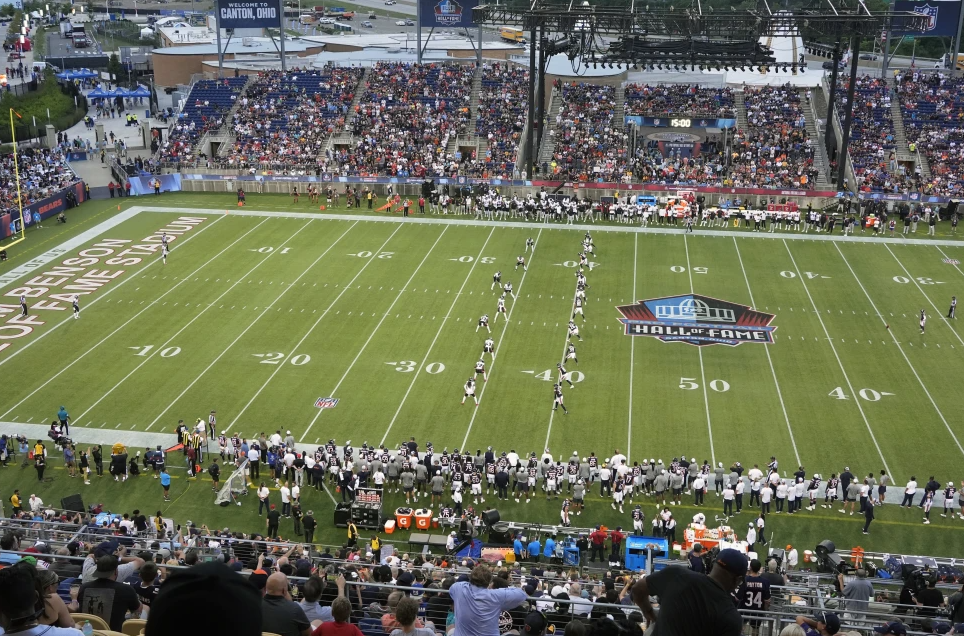NFL Kickoff Rule Change Debuts at Hall of Fame Game

In the NFL’s first game showcasing the new kickoff rules, both initial kickoffs were returned to the 26-yard line.
CANTON, Ohio (WE) — The NFL’s annual Hall of Fame game on Thursday night between the Houston Texans and Chicago Bears marked the debut of the league’s newly introduced kickoff rules. These significant alterations are designed to revitalize the kickoff play, which experienced a decline in returns last season, reaching a record low.
The game began with Houston’s Steven Sims fielding Cairo Santos‘ kickoff at the 5-yard line, advancing it 21 yards to the 26-yard line. Under the previous rule, a touchback would have placed the offense at the 25-yard line. Following a touchdown by the Texans, Chicago’s Tyler Scott received Ka’imi Fairbairn’s kickoff at the 7-yard line and returned it 19 yards to the 26-yard line. Both returns slightly exceeded the previous touchback distance, suggesting that the new rules may encourage more active returns.
First NFL kickoff with the new rules— The Kevin Harlan Effect (@KevHarlanEffect) August 2, 2024
🏈 First NFL kickoff with the new rules: pic.twitter.com/HzVkxNb7wX
— The Kevin Harlan Effect (@KevHarlanEffect) August 2, 2024
The NFL’s decision to amend the kickoff rules was driven by a desire to rejuvenate what had become a largely ineffective play. The revised rules stipulate that kickoffs are now executed from the 35-yard line, with 10 kick coverage players lined up at the opposing 40-yard line, split evenly across the field. The return team must position at least nine blockers within a “set-up zone” between the 30- and 35-yard lines, with a minimum of seven touching the 35-yard line. Additionally, up to two returners are permitted inside the 20-yard line.
What Are the Kickoff Rule Changes in the NFL?
The NFL has revamped its kickoff rules to enhance player safety and boost the excitement of returns. These changes, inspired by the XFL’s 2020 and 2023 rules, mark a departure from past regulations aimed at reducing high-speed collisions and limiting returns. Here’s a summary of the new kickoff rules:
Kickoff Positioning:
- Old Rule: Kickoffs were made from the kicking team’s 35-yard line.
- New Rule: Kickoffs continue from the 35-yard line.
Player Alignment:
- Old Rule: The 10 kicking team members lined up at their own 35-yard line.
- New Rule: They now line up at the receiving team’s 40-yard line. The receiving team’s 9-10 players line up in the “setup zone” between the 30- and 35-yard lines.
Returners:
- Old Rule: Typically, one returner was stationed near the goal line.
- New Rule: Teams can have one or two returners positioned between the goal line and the 20-yard line.
Movement During the Kick:
- Old Rule: All players could move while the ball was in the air.
- New Rule: Only the kicker and returner(s) can move while the ball is in the air; other players must remain stationary.
Touchback and Ball Positioning:
- Old Rule: A touchback or ball going out of the end zone placed the offense at the 25-yard line. Balls kicked out of bounds were spotted at the 40-yard line.
- New Rule: Touchbacks and balls out of the end zone result in starting at the 30-yard line, while balls kicked out of bounds are still spotted at the 40-yard line.
Ball Placement:
- Old Rule: The ball was live if it landed or was fielded before reaching the 20-yard line.
- New Rule: The ball is spotted at the 40-yard line if it lands or is fielded before reaching the 20-yard line.
The main thing that I’ll be looking at tonight is the new #NFL kickoff rules. Going to be interesting to see how it works out this season. pic.twitter.com/W8bd0FvuEJ
— Jake Friel (@Jake_FrieI) August 1, 2024
Side Effects of the NFL’s New Kickoff Rules
The NFL’s recent overhaul of kickoff rules has introduced several unintended side effects that teams are beginning to assess. While the primary aim of these changes was to enhance player safety and invigorate the kickoff play, they have also prompted shifts in key game metrics that could influence strategic decisions throughout the season.
Player and Coach Reactions
While the initial returns may seem minor, the new rules are anticipated to have broader implications on strategy and player safety. “We’re still adjusting to the changes,” said Texans head coach DeMeco Ryans. “It’s going to alter how we approach both kicking and returning. We’re emphasizing more on strategic placement and coverage.”
Bears special teams coordinator Richard Hightower echoed these sentiments, noting that the alterations could lead to a shift in how teams deploy their personnel. “The new setup forces us to rethink our formations and timing. It’s not just about where the ball lands but how quickly and efficiently we can cover it,” he remarked.
Safety Concerns and Player Health
One of the primary motivations behind the rule change was player safety. Kickoffs have traditionally been one of the most dangerous plays in football due to high-speed collisions. By modifying the kickoff structure, the NFL aims to reduce the frequency and severity of these impacts.
“The goal is to decrease the high-impact collisions that have led to injuries,” said NFL executive vice president of football operations Troy Vincent. “We’re committed to making the game safer while maintaining its excitement and competitiveness.”
Want a crash course on the @NFL’s Dynamic Kickoff rule? 🏈@Saints Special Teams Coordinator, Darren Rizzi walks you through it! 👇🏿
— Troy Vincent, Sr. (@TroyVincentSr) July 31, 2024
Check out my full discussion of the new rule with coaches Fassel (@dallascowboys), Rizzi and Hightower (@ChicagoBears): https://t.co/Fru6H2s5Ua pic.twitter.com/qZqZW3COaB
Early Observations and Future Adjustments
The Hall of Fame game provided a glimpse into the potential effects of the new rules, but it will take more time and a larger sample size to fully understand their impact. “It’s too early to draw definitive conclusions,” said ESPN analyst Louis Riddick. “We’ll need to see how these changes play out over the course of the preseason and into the regular season.”
As teams continue to adapt, further adjustments to strategy and execution are expected. “We’re all in the same boat, learning and adapting,” said Bears head coach Matt Eberflus. “Our focus is on making the most of these changes and ensuring our players are prepared and protected.”
Looking Ahead
The NFL’s willingness to experiment with and refine its rules reflects a broader commitment to enhancing the game. The immediate effects of the new kickoff rules are unfolding, and their long-term impact on player safety and game strategy will be closely monitored. As the season progresses, the league will continue to assess the effectiveness of these changes and consider any necessary adjustments to ensure optimal outcomes for both players and the sport.
















2 Comments